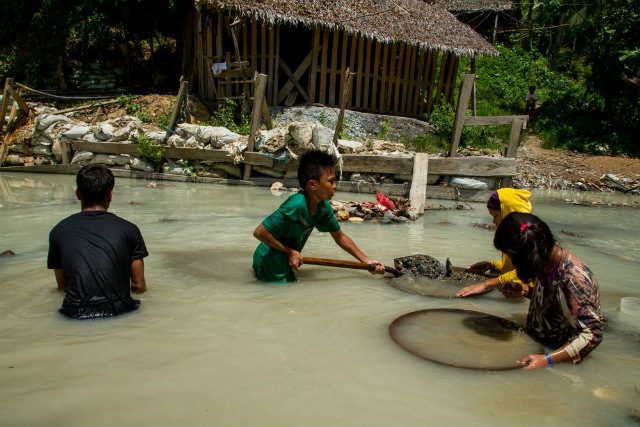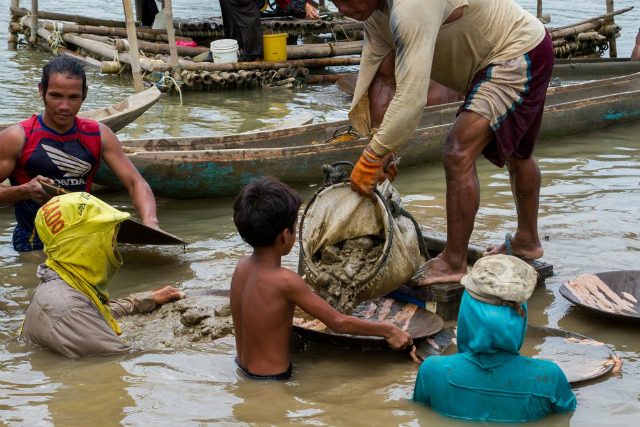SUMMARY
This is AI generated summarization, which may have errors. For context, always refer to the full article.

MANILA, Philippines (UPDATED) – The New York-based Human Rights Watch (HRW) slammed the Philippine government for its alleged failure to “protect children who dig and dive for gold in dangerous small-scale mines.”
The group released Wednesday, September 30, its report on the subject, highlighting hazardous conditions child miners for gold are made to endure.
“Children work in unstable 25-meter-deep pits that could collapse at any moment. They mine gold underwater, along the shore, or in rivers, with oxygen tubes in their mouths,” the report read.
“They also process gold with mercury, a toxic metal, risking irreversible health damage from mercury poisoning,” it added.
The report, entitled “What…if Something Went Wrong: Hazardous Child Labor in Small-Scale Gold Mining in the Philippines,” documented the experiences of over 135 people, including 65 child miners aged 9 to 17 in small-scale gold mines in the provinces of Camarines Norte and Masbate during the years 2014 and 2015.
Juliane Kippenberg, HRW associate children’s rights director, wrote the report.
Kippenberg concluded that the problem of child labor is one of enforcement, and stressed the need to empower Filipino families to move out of poverty. This would remove the need for even minors in the family to work.
“In order to tackle the root causes of child labor, the government needs to assist the poorest families financially and ensure their children are able to attend and stay in school,” she explained.
“The government needs to take urgent steps to ensure a safe and child-labor-free mining sector so that families can earn income without putting their children at risk,” she added.
Risks of hazardous work
HRW found that both underground mines and underwater or compressor mines put the children at risk of injuries from mine collapse and drowning, respectively.
In compressor mining, some adolescent boys are made to stay “underwater for several hours at a time in 10-meter-deep shafts.”
“I was 13 the first time [I dived]. I felt scared because it’s dark and deep,” the HRW report quoted one of the child miners.
“Sometimes you have to make it up fast, especially if you have no air in your hose. It’s a normal thing. It’s happened to me,” said another.
Exposure to mercury during the processing of gold also make the children vulnerable to brain damage, the report said.
Supposedly, state laws do not permit compressor mining and mercury in mining.
Despite the ban instituted in March, there remains a struggle in implementing the law.
“The Philippine government should be introducing mercury-free gold processing, as practiced in Benguet province, to reduce the threat to all children,” HRW urged.
The group also said the Philippines must ratify the Minamata Convention on Mercury of 2013, aside from “testing mercury exposure among residents in mining areas.”
While the Philippines benefits from small-scale mining in the provinces, HRW said the industry must be rid of any and all elements that force children to live adult lives.

Child labor in the Philippines
Under Philippine law, “child labor refers to the employment of children who are below 18 years old that deprives them of their childhood, interferes with their ability to attend regular school, and that is mentally, physically, socially, or morally dangerous and harmful.”
Citing government data, the International Labor Organization on June 10 said there are 2.1 million child laborers aged 5-17 years old in the Philippines.
About 96% of the child laborers are involved in hazardous work.
State figures for 2011 show that there are 5.5 million children in the Philippines engaged in labor, including permissible work for children.
In the Philippines, employing a child laborer in hazardous work is a crime punishable under Republic Act 9231, which seeks to eliminate the worst forms of child labor in the country. It is also punishable under RA 7610, which grants special protection for children against abuse, exploitation, and discrimination.
Those guilty of child labor could face a fine ranging from P100,000 to P1 million or imprisonment from 12 years and one day to 20 years or both, depending on the court’s verdict.
Labor Secretary Rosalinda Baldoz has urged teachers to help identify child laborers among students exhibiting absenteeism, habitual tardiness, poor performance, and other similar indicators.
Child labor “interferes with a child’s right to education, as well as risks a child’s health, safety, and development,” she said. – Rappler.com
Add a comment
How does this make you feel?





There are no comments yet. Add your comment to start the conversation.